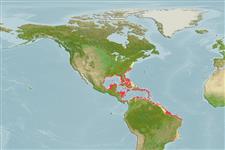Common names from other countries
Environment: milieu / climate zone / depth range / distribution range
Ecología
marino asociado a arrecife; no migratorio; rango de profundidad 2 - 60 m (Ref. 9626). Tropical; 22°C - 28°C; 44°N - 23°S, 98°W - 34°W
Western Atlantic: New England, USA to the vicinity of Rio de Janeiro, Brazil, including the Gulf of Mexico and the Caribbean (Ref. 26938).
Length at first maturity / Tamaño / Peso / Age
Maturity: Lm 22.6 range ? - ? cm
Max length : 60.0 cm TL macho / no sexado; (Ref. 3797); common length : 45.0 cm TL macho / no sexado; (Ref. 3797); peso máximo publicado: 1.8 kg (Ref. 40637)
Espinas dorsales (total): 9; Radios blandos dorsales (total): 31-33; Espinas anales 3; Radios blandos anales: 23 - 25. Pale gray around mouth, and pale gray margin on caudal fin. Inside of pectoral fin yellow (Ref. 26938). Juveniles are black with two light yellow bars on body and three on head; caudal fin yellow with a vertically elongate, nearly rectangular or hemispherical black spot in middle (Ref. 13442).
Maximum depth from Ref. 126840. Common in coral reefs, usually solitary, occasionally in pairs. Juveniles are part-time cleaners. Feed mainly on sponges, but also takes tunicates, algae, zoantharians, gorgonians, hydroids, bryozoans, and seagrasses. Oviparous (Ref. 240), monogamous (Ref. 52884). Flesh reported to be of excellent quality (Ref. 3797); marketed fresh and salted (Ref. 5217). Friendly toward divers (Ref. 9710). Have been reared in captivity (Ref. 35419).
Life cycle and mating behavior
Madurez | Reproducción | Puesta | Huevos | Fecundidad | Larva
Monogamous mating is observed as both facultative and social (Ref. 52884).
Allen, G.R., 1985. Butterfly and angelfishes of the world. Vol. 2. 3rd edit. in English. Mergus Publishers, Melle, Germany. (Ref. 4858)
IUCN Red List Status (Ref. 130435)
CITES (Ref. 128078)
Not Evaluated
Threat to humans
Reports of ciguatera poisoning (Ref. 30303)
Human uses
Warning: mysqli::__construct(): (08004/1040): Too many connections in /var/www/html/includes/func_getlabel.php on line 46
Can't connect to MySQL database (fbapp). Errorcode: Too many connections
